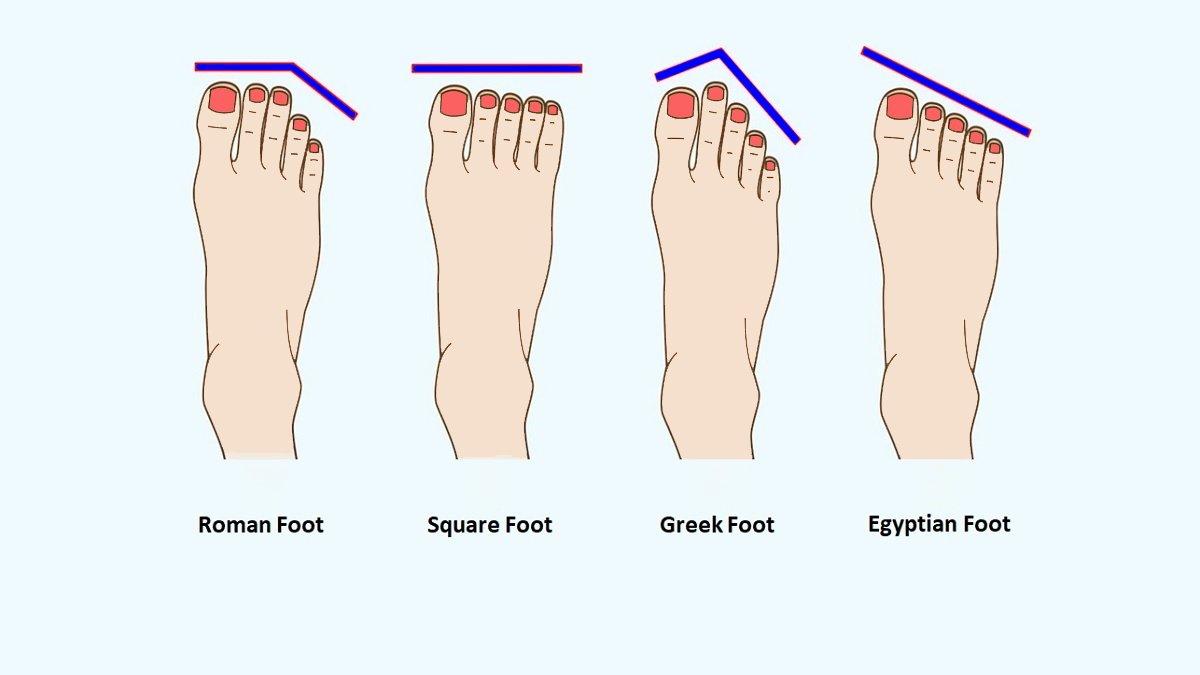How does the shape of your feet tell others about your personality?
The idea that the shape of your feet can tell others about your personality is a concept rooted more in pseudoscience and folklore than in scientific evidence. This notion is somewhat similar to palmistry, where the lines on your palms supposedly reveal aspects of your character or future. In the context of feet, different cultures might have various interpretations of how foot shape is linked to personality traits. However, it’s important to note that there is no scientific basis for these beliefs, and they should be taken with a grain of salt. Here are a few examples of how some people might interpret foot shapes:
Table of Content:
- Roman Foot (Square Foot)
- Greek Foot (Morton’s Toe)
- Egyptian Foot
- Peasant Foot (Square Foot)
- High-Arched Foot (Pes Cavus)
- Flat Foot (Pes Planus)
- Extras (Cultural and Historical Aspects about foot)
- Roman Foot (Square Foot)
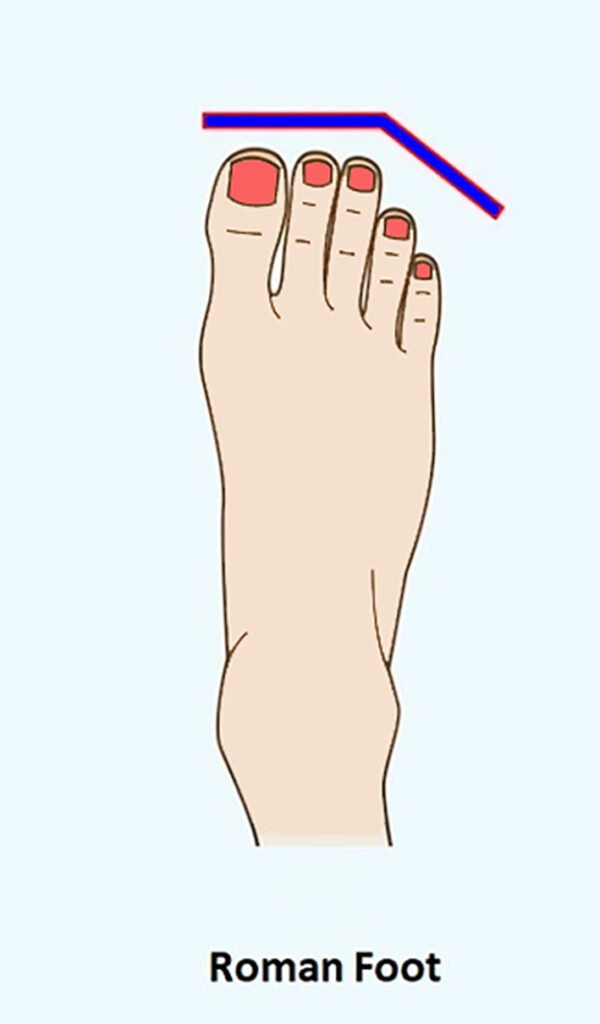
This foot type is characterized by the first three toes being of the same length, with the other two tapering off. It’s often considered a sign of a well-balanced and outgoing personality. People with this foot shape are sometimes described as sociable and charismatic, has been subject to various interpretations in folklore and pseudoscience regarding personality traits. However, it’s important to emphasize that these interpretations lack scientific support and are more reflective of human curiosity and the desire to find patterns in physical attributes than they are of any verifiable truth.
Folklore and Personality Traits:
Individuals with a Roman Foot are often described as having a well-balanced and outgoing personality. They are thought to be sociable, charismatic, and good at communicating with others. The idea is that the balanced nature of the foot reflects a balanced personality, capable of both leadership and collaboration.
This foot type is named after its prevalence in classical Roman sculpture, where it was considered aesthetically ideal. The association with Roman culture, known for its advancements in law, politics, and the arts, may contribute to the positive traits attributed to individuals with this foot shape.
Practical Considerations:
Beyond folklore, the Roman Foot is considered quite functional and versatile, suited for various activities due to its balanced shape. People with this foot type might find it easier to find comfortable footwear because their foot shape can handle a wide range of shoe styles.
Conclusion:
While it’s fascinating to explore how different cultures interpret physical characteristics like foot shapes, it’s crucial to approach these interpretations with skepticism. Personality traits are complex and influenced by a myriad of factors including genetics, environment, and personal experiences. Physical characteristics like the shape of one’s foot do not hold the key to understanding someone’s personality.
- Greek Foot (Morton’s Toe)
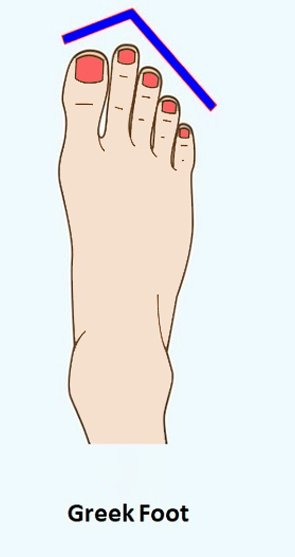
In this case, the second toe is longer than the big toe. It’s named after the idealized form in Greek sculpture. This foot shape has been associated with leadership qualities, creativity, and a somewhat impulsive nature.
The Greek Foot, also known as Morton’s Toe, is a foot shape where the second toe is longer than the big toe. This characteristic has been celebrated in classical art and architecture, symbolizing beauty and ideal proportions in ancient Greek culture. However, the notion that the Greek Foot can reveal specific personality traits is rooted in pseudoscience and folklore rather than empirical evidence.
Folklore and Personality Traits:
Individuals with a Greek Foot are often described as having certain personality characteristics. They are sometimes seen as creative, ambitious, and possessing a natural leadership quality. The association with ancient Greek culture, which was renowned for its contributions to philosophy, democracy, and the arts, may influence these perceived traits. People with this foot type are also thought to be active, dynamic, and somewhat adventurous, always looking for new experiences and challenges.
Practical Considerations:
From a practical standpoint, having a Greek Foot or Morton’s Toe can sometimes lead to discomfort, especially when wearing certain types of shoes that do not accommodate the longer second toe. It’s essential for individuals with this foot shape to choose footwear that provides enough room to avoid pressure or pain.
Conclusion:
While it’s intriguing to consider how ancient beliefs and modern interpretations link physical attributes to personality traits, it’s important to remember that these connections are not supported by scientific evidence. Personality is shaped by a complex interplay of genetic, environmental, and experiential factors, and cannot be accurately assessed based on the shape of one’s feet.
- Egyptian Foot
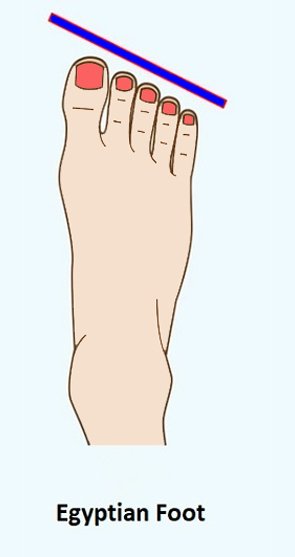
This foot shape features a long big toe, with the other toes tapering down smoothly in size. It’s often linked to a personality that is mysterious and keeps emotions guarded, with a tendency towards introversion.
The Egyptian Foot, characterized by a long big toe with the other toes tapering down in size in a diagonal line, is another foot shape around which certain folklore and pseudoscientific ideas have been constructed, regarding personality traits. It’s worth noting again, however, that these ideas don’t have a basis in scientific evidence but are part of human nature’s fascination with trying to derive meaning from physical characteristics.
Folklore and Personality Traits:
People with the Egyptian Foot shape are sometimes described in folklore as having personalities that are mysterious or enigmatic. They might be viewed as introverted or private, preferring to keep their thoughts and feelings to themselves. This foot shape is often associated with someone who is practical and reliable but also somewhat reserved, enjoying moments of solitude or reflection.
The idea may stem from the allure and mystique of ancient Egyptian civilization, known for its profound contributions to art, architecture, and early forms of writing, among other things. The connection between this foot type and personality traits is purely speculative and part of a larger human tendency to find patterns or meaning in physical attributes.
Practical Considerations:
From a practical standpoint, the Egyptian Foot shape, like any other, has implications for the types of shoes that might be most comfortable or suitable, given the distinct tapering of toe length. Finding footwear that accommodates the longer big toe without squeezing the smaller toes is important for individuals with this foot shape.
In conclusion, while it’s intriguing to explore the meanings people have historically associated with different foot shapes, such as the Egyptian Foot, it’s essential to remember that personality is a complex interplay of many factors. Physical characteristics like foot shape don’t provide real insight into someone’s character or disposition.
- Peasant Foot (Square Foot)
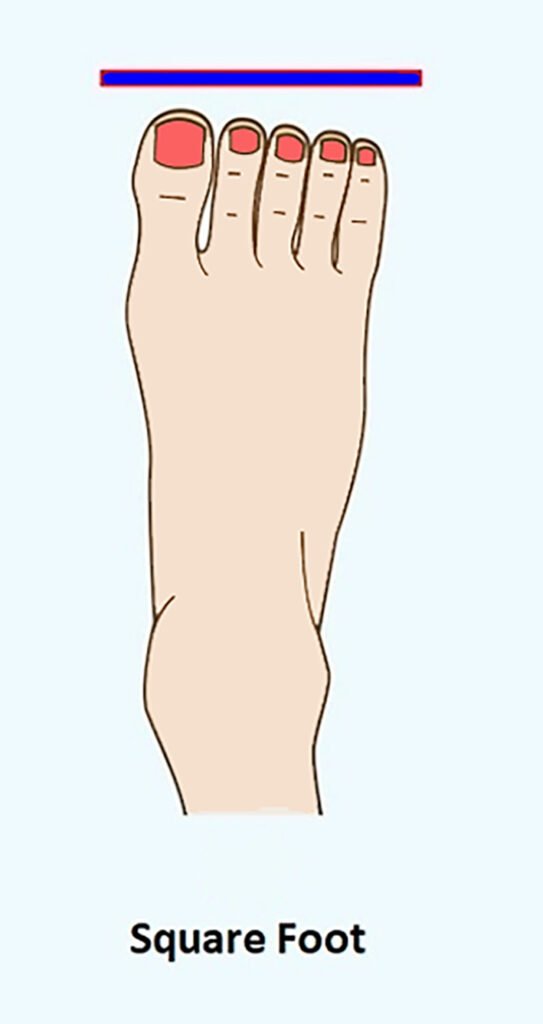
A variation of the Roman foot, where all toes are almost the same length, giving the foot a square appearance. This is sometimes interpreted as indicative of a practical, hardworking, and steadfast personality.
Personality traits are complex and influenced by a myriad of factors including genetics, environment, and experiences. While it’s entertaining to explore such folklore, it should not be taken as a serious assessment of one’s character or personality.
The Peasant Foot, also referred to as a Square Foot due to its shape where all toes, including the big toe, are of a similar length, making the front of the foot look rather squared, has its own set of folklore-based personality traits. Like with other foot shapes, it’s crucial to highlight that these personality descriptions are not rooted in scientific evidence but stem from human tendencies to ascribe meaning to physical characteristics.
Folklore and Personality Traits:
Individuals with a Peasant Foot are often described as having a practical, steadfast, and hardworking personality. This foot shape is sometimes associated with a solid, reliable character, possibly because the term “peasant” evokes images of agricultural workers who are traditionally seen as embodying these qualities. People with this foot type are also thought to be extremely down-to-earth and may possess a strong sense of loyalty and a pragmatic approach to life’s challenges.
Practical Considerations:
From a functional perspective, the Peasant Foot’s shape, with its broad and square appearance, might offer a stable base for walking and standing, potentially contributing to a sturdy and resilient physical constitution. This could align with the folklore that suggests individuals with this foot type are hardworking and dependable.
Conclusion:
While exploring the folklore surrounding different foot shapes can be fascinating, it’s important to approach these ideas with a critical mind. The suggestion that a person’s foot shape can dictate their personality lacks empirical support. Personality is influenced by a wide array of factors, including but not limited to genetics, upbringing, culture, and personal experiences. The shape of one’s foot is not a reliable indicator of one’s character or behavioural tendencies.
- High-Arched Foot (Pes Cavus)
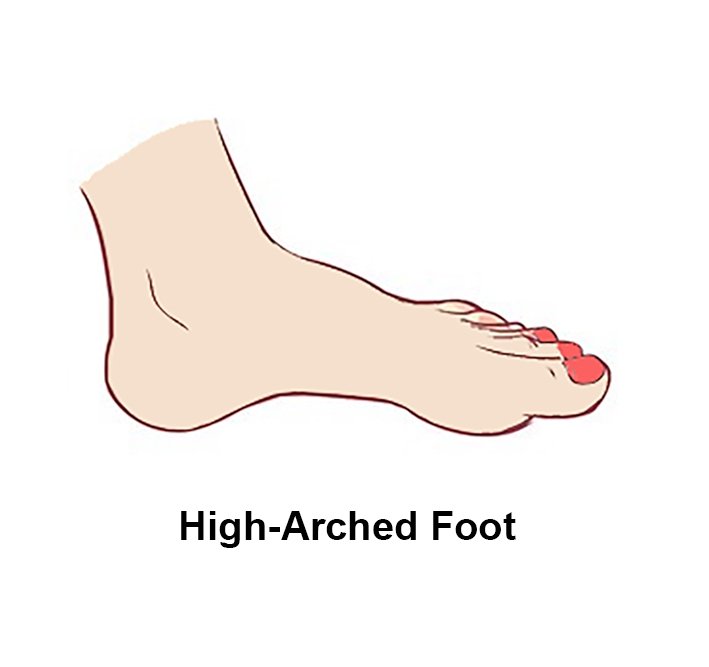
This foot has a higher-than-normal arch, which can lead to excessive weight being placed on the ball and heel of the foot when walking or standing. People with high arches may be more prone to ankle instability and plantar fasciitis.
The association between having a High-Arched Foot (Pes Cavus) and specific personality traits is, like other foot shape-based personality attributions, not founded on scientific evidence. Instead, these ideas belong to the realm of folklore, pseudoscience, and fun speculation rather than empirical psychology or medical science. The concept that physical characteristics, such as the shape or arch of one’s foot, can dictate personality traits has no basis in scientific research. Personality is shaped by a complex interplay of genetics, environment, experiences, and individual choices.
High-Arched Foot Characteristics:
Individuals with high-arched feet tend to have a more pronounced curve on the underside of their foot. This can sometimes lead to challenges with footwear, as certain styles may not provide adequate support or cushioning, leading to discomfort. High arches are also associated with certain biomechanical implications, such as a propensity for ankle sprains, due to the reduced ability to absorb shock, and issues like plantar fasciitis or metatarsalgia due to uneven weight distribution on the foot.
Folklore and Speculation:
If one were to speculate based on the non-scientific tradition of linking foot shapes to personality (purely for entertainment), someone might say that individuals with high-arched feet are “head in the clouds” types, possibly attributing to them qualities of creativity or a tendency towards introspection and independence. This could be creatively rationalized by the physical characteristic of the foot being less grounded due to the higher arch. However, this is purely imaginative and not grounded in any factual evidence.
Conclusion:
It’s crucial to remember that linking physical characteristics to personality traits does not have a basis in science. While it can be fun to explore these myths and folklore, they should not be taken seriously in understanding an individual’s personality or behavior. Personality assessments are complex and should be based on comprehensive evaluations involving behavior, cognition, and emotional patterns over time, not on physical attributes like the shape or arch of one’s foot.
- Flat Foot (Pes Planus)
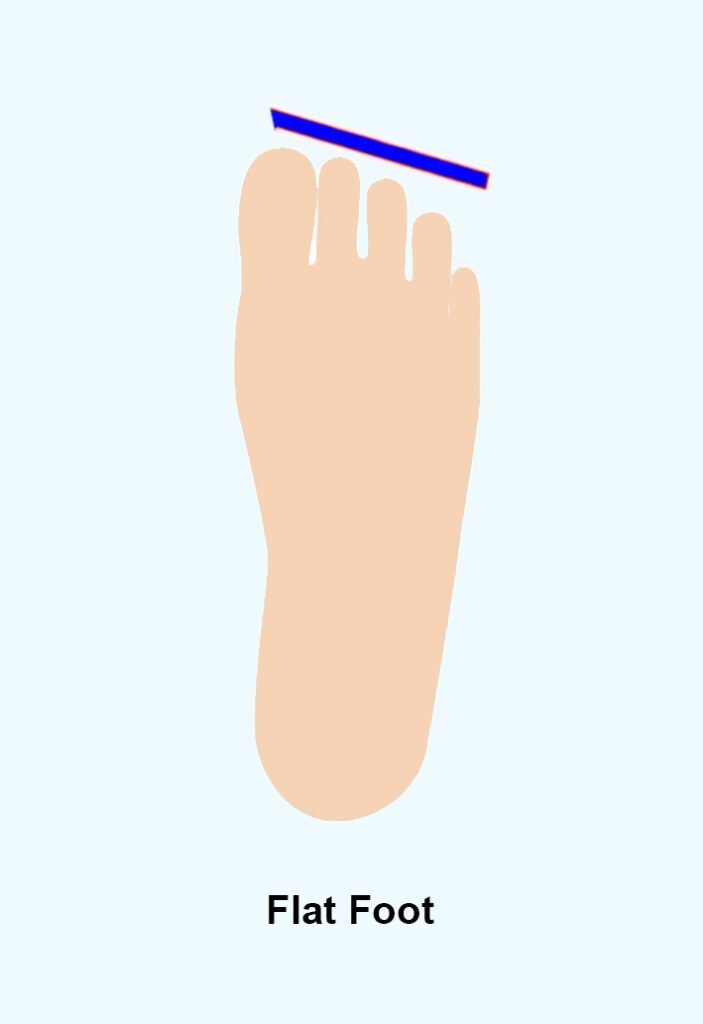
The arch of the foot is lower than usual or nonexistent, causing the entire sole to touch the ground when standing. Flat feet can lead to foot pain and problems with alignment in some people, though others may experience no symptoms at all.
The idea that having a Flat Foot (Pes Planus) could indicate certain personality traits is, like with other foot shapes, a notion found in folklore and not supported by scientific evidence. Personality is a complex interplay of genetics, environment, and countless individual experiences, and it cannot be accurately inferred from physical attributes such as the shape or arch of one’s foot.
Flat Foot Characteristics:
Flat feet are characterized by a lowering of the arch, causing the soles of the feet to come into complete or near-complete contact with the ground. While many individuals with flat feet experience no issues, some may encounter discomfort or pain, particularly in the heel or arch area, especially after prolonged activities. Flat feet can sometimes lead to problems with overpronation, which may affect the alignment and cause issues in the knees, hips, or back.
Folklore and Speculation:
In the realm of speculative and non-scientific beliefs, one might encounter playful assertions that individuals with flat feet are practical, down-to-earth, and reliable, possibly drawing a symbolic connection between the physical trait of having “both feet firmly on the ground” and a grounded or pragmatic personality. Again, these kinds of speculations are for entertainment rather than serious personality analysis.
Conclusion:
It’s important to approach any claims linking physical characteristics like foot shape to personality with skepticism. There is no scientific basis for these assertions, and they do not hold up under psychological or physiological scrutiny. Understanding personality requires a comprehensive approach that considers cognitive, emotional, and social dynamics, far beyond the scope of simple physical traits.
7. Cultural and Historical Aspects about foot
The history and cultural aspects of feet and foot practices vary significantly across different civilizations and time periods, reflecting diverse beliefs, aesthetics, social structures, and practical needs. Here are some notable aspects:
- Foot Binding in China
One of the most infamous cultural practices related to feet is foot binding in China. This practice involved tightly wrapping the feet of young girls with cloth to prevent them from growing, resulting in “lotus feet.” It was considered a symbol of beauty and status, as it indicated that a woman was from a family wealthy enough that she did not need to work. Foot binding began during the Song Dynasty (960-1279 AD) and was not officially banned until the early 20th century, though it continued in some areas for years afterward.
- Barefoot vs. Footwear
The cultural significance of being barefoot versus wearing shoes varies greatly. In many Western cultures, wearing shoes is the norm, and being barefoot can be seen as a sign of poverty or lack of civility. In contrast, in many Eastern and African cultures, removing shoes before entering a home is a sign of respect, as it keeps the home clean and acknowledges the sanctity of the domestic space.
- Footwear Styles
Footwear has been used for protection, performance enhancement, and as a status symbol throughout history. The design, material, and style of footwear can signify one’s social status, profession, and cultural affiliation. For example, the red-soled shoes of Christian Louboutin have become a contemporary status symbol, while traditional Japanese geta sandals serve practical purposes and cultural expression.
- Foot Washing
In many religions and cultures, washing feet is a sign of hospitality, humility, and respect. In Christianity, Jesus washing the feet of his disciples is a significant act of humility and service. In Islam, washing the feet is part of the ablution process before prayer.
- Podomancy
Podomancy, or foot reading, is a form of divination based on the shape, lines, and various characteristics of the feet. It has been practiced in different forms across various cultures, including India and China, where it is believed that one’s feet can reveal their personality, fate, and health.
- Feet in Art and Literature
Feet and footwear appear symbolically in art and literature, often representing themes of travel, transformation, and character. For example, Cinderella’s glass slipper is central to her story’s themes of identity and change.
Conclusion
Feet and their treatment (from the practice of foot binding to the symbolism of bare footedness and the use of footwear) have been imbued with deep cultural, social, and symbolic meanings throughout human history. These practices reflect the complex ways in which societies view the human body and articulate social norms, aesthetics, and values.

